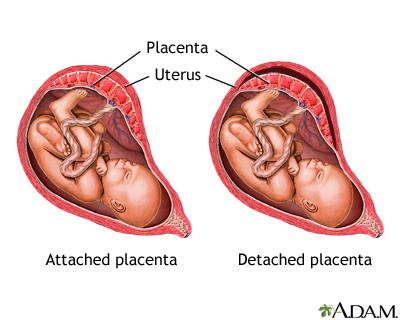

  |
Placenta abruptio is the separation of the placenta from the inner wall of the uterus before the baby is delivered. Alternate names are placental abruption and abruptio placentae.

In most pregnancies, the placenta remains firmly attached to the upper part of the uterine wall. In one out of 150 pregnancies - usually during the third trimester - the placenta detaches itself from the wall of the uterus prematurely, causing bleeding. Sometimes only a portion of the placenta separates; other times it pulls away completely.
The placenta is the fetus’s lifeline, and if it becomes detached, it’s a serious problem. Placenta abruptio decreases the supply of oxygen and nutrients to the fetus, making it one of the leading causes of fetal death in the third trimester. However, more than 90% of their babies survive placenta abruptio. Maternal death is rare.
No one fully understands what causes placenta abruptio, but women with chronic high blood pressure have the highest risk. Other risk factors include heart disease, diabetes, smoking, and alcohol or cocaine use. Women who are African American, older than 40, or have had a previous placenta abruptio are also more likely to experience it. An injury to the mother, such as a car crash, can also cause an abruption.
The most common symptoms are vaginal bleeding and painful contractions. The amount of bleeding depends on how much of the placenta has detached.
Sometimes the blood accumulates between the placenta and uterine wall, so there is no noticeable bleeding from the vagina. Be aware of other symptoms, such as abdominal cramping or severe pain, backache, and reduced fetal movement.
If you notice any of these symptoms or any kind of vaginal bleeding during your pregnancy, contact your health care provider right away.
Evaluation begins with a physical exam. Your health care provider will also observe your uterine contractions and your fetus' response to them. You may also have an ultrasound; however, only half of placenta abruptios can be detected this way (For information on what to expect from an ultrasound, click here).
If your placental separation is minor, your health care provider may suggest bed rest to stop the bleeding. After a few days, you can usually resume your normal activities.
If moderate separation occurs, you'll probably have to stay in the hospital so your medical team can carefully observe both you and your fetus. Your doctor may use electronic monitoring to look at the fetus' heart rate. You might need a blood transfusion. If the fetus shows any signs of distress, your doctor may induce early delivery. If you can't give birth vaginally, your doctor will perform a c-section (cesarean).
A severe placental separation is an emergency. Your doctor will deliver your baby immediately - usually by c-section - if there is any sign that your baby is in distress. In about 1 in 800 pregnancies, placental abruption causes a stillbirth.
While placenta abruptio cannot be prevented, your best bet is to keep the conditions related to it - high blood pressure, heart disease, and diabetes - under control. You can further reduce your risk by avoiding tobacco, alcohol, and cocaine. If you have had an abruption in a previous pregnancy, talk to your health care provider about possible prevention strategies.
Q: What's the difference between placenta abruptio and placenta previa?
A: With placenta abruptio, the placenta partially or completely detaches itself from the uterine wall before delivery. With placenta previa, the placenta is located over or near the cervix, in the lower part of the uterus. Patients with placenta abruption usually experience painful contractions with bleeding, whereas those with placenta previa experience painless bleeding. In both cases you are more likely to have a c-section. Both of these conditions can lead to profound hemorrhage and can be dangerous to both mother and fetus if not treated promptly. However, with ultrasound and fetal heart rate monitoring, both conditions can usually be managed successfully.
Q: I've had some vaginal bleeding during my third trimester of pregnancy. Could this mean I have placenta abruptio?
A: Immediately report any bleeding during late pregnancy to your health care provider. Placenta abruptio can be diagnosed by a process of elimination. First, your provider will determine if you have placenta previa. If this and other causes of bleeding are eliminated, there might be a chance that you have placenta abruptio. Other causes of late-term vaginal bleeding may include:
Q: I've had placenta abruptio before. What are my chances of getting it again with my next pregnancy?
A: If you've had placenta abruptio before, your chances of experiencing it again are about one in 20.